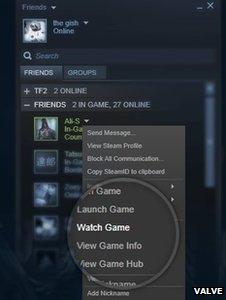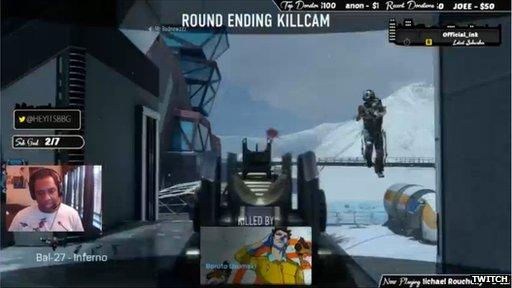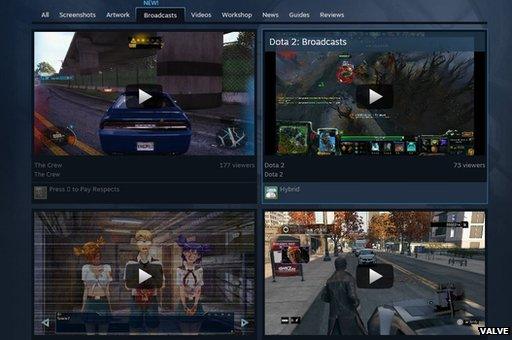Steam Broadcasting takes on Twitch with game streams
- Published

Players can watch each others' progress and provide comments via a chat window
Steam - the popular PC video gaming platform - is adding the ability to stream gameplay so that others can watch online.
The move presents a challenge to Twitch, which is built around a similar service, and was acquired by Amazon for $970m (£618m) in September.
Steam has more than 100 million active accounts, external, nearly double the 60 million visitors a month claimed by Twitch, external.
But one expert suggested Twitch was still likely to dominate the sector.
Privacy options
Steam is software provided by the US company Valve that allows people to buy, support development of, play and discuss titles created by thousands of video game publishers.
It has emerged as the most popular way to buy Windows PC games. It also offers Mac and Linux-based software.

Players can see which games their friends are playing and then ask to watch progress
Steam's new facility can be accessed three different ways:
via the Community section of its platform in a new sub-section called Broadcasts, which provides a list of games currently being played by random users
via the platform's Friends menu or from a specific friend's profiles, which allows a user to follow the action of people in their social circle
via an invitation sent by a friend who is already playing
Anyone playing a game via Valve's software can opt to let their progress be watched by others, and they are offered various privacy options, external that allow them to control who can activate a stream.
Broadcasters can provide voice-over commentary and text chat, but cannot appear in a superimposed webcam feed window as is common on Twitch, although they can show other computer desktop activity when not in-game.
Other restrictions include the fact that broadcasts cannot be saved to be watched back later, and that players have no obvious way to make money from their streams - two activities Twitch allows. However, Steam benefits from the fact that it does not require visitors to watch adverts before game streams begin.
"Valve has listened to what its customers have been asking for and has offered live broadcasting in its own way, which basically provides it with free marketing for the games sold on its platform," said Lewis Ward, a video games analyst from the IDC consultancy.

Twitch offers streamers the ability to embed a webcam feed of their face on top of gameplay
"Getting into the streams is very easy, and it seems it's done enough on the security side so if you don't want certain people to view your activity or are a parent who has concerns about your kids, there are ways to block it.
"So, it's done the core of what Twitch does but still lacks some aspects that make Twitch distinctive. And while I think it's a very interesting first step, I don't think it matches where Twitch is today."
The two companies are not alone in efforts to make gaming a spectator sport.
Google's YouTube is another major force, allowing players to stream and watch live gameplay as well as pre-recorded clips.
Hitbox.tv, Ustream and the in-development GamingLive.tv provide other alternatives.
But Mr Ward suggested that Steam Broadcasting should be able to co-exist alongside the dominant player.

Valve offers the ability to watch random users playing via its new Community Games Hub
"Twitch is platform-agnostic - it's kind of like Switzerland - and that neutrality means it can partner with lots of different companies," he said.
"It can focus on mobile and consoles as well as PCs - Twitch and Steam started allowing account linking over a year ago - so, I think it can take a broader view of gaming broadcast capabilities, which is where the market is going.
"And so long as Valve stays focused only on broadcasts of games played on its platform, then that's going to limit the potential growth of the new service."
- Published5 November 2014

- Published20 October 2014

- Published25 August 2014
